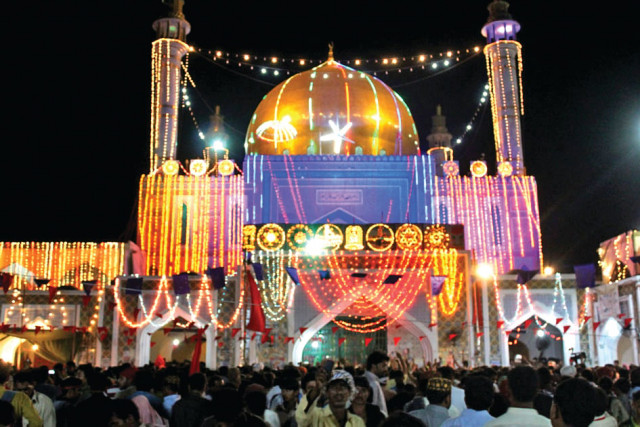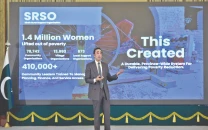Religious harmony: When spirituality trumps religious boundaries
People of all religions show love and devotion to Sindh’s Muslim Sufi saints for several generations

Thousands of devotees gather at 13th century Sufi Saint Lal Shahbaz Qalandar’s shrine in Sehwan each year. PHOTO: FILE
Universal message
This phenomenon is quite common among the Hindus of Sindh, who have been regular visitors to the tomb of Muslim Sufi saints for many generations. Not only that, but they also seek spiritual guidance from murshids living in various parts of the province.
Anand Lakhwani, a landlord who belongs to Sanghar district has completed his post-graduate studies, but he frequently visits the shrine of Naseer Fareer Jalalani, a Muslim saint buried near Khairpur.
“My forefathers were devotees of this shrine. The Sufis did not believe in a single religion but gave the lesson of humanity that is enshrined in the Holy Quran too. The caretaker of this shrine is our ‘murshid’ who still guides us to do good things in the name of Allah, or whatever deity you believe in,” Lakhwani explained.
The shrine of Faqeer Jalani is around 250 years old and, according to Lakhwani, he spread the idea that human beings are superior to religion.
This is not a rare case, many shrines of Muslim Sufis like Shah Abdul Bhittai in Halla, Sachal Sarmast in Daraza, Lal Shahbaz Qalandar in Sehwan, Bedil and Bekas in Rohri, Shah Inayat Shaheed in Jhok, and Odero Lal in Tando Adam, among others, are regularly visited by members of the Hindu community who go there to attain a sense of relief and relaxation.
Bhagwan Devi, a Hindu doctor who lives in Hyderabad, pays a visit to the Shah Latif Bhittai shrine every weekend because she believes that saints do not belong to a particular sect or religion.
“Our entire family here in Pakistan and even in India considers Shah Latif a man of wisdom, who loved the people of this land,” she said. “Shah Latif is everything for us, which is why even our family members living in the United States of America and Europe visit Pakistan on his death anniversary every year.”
She said that apart from giving guidance to people in their daily lives, Muslim Sufis also spread the message of love, peace, tolerance and co-existence.
Sufi Shah Inayat Shaheed
Dr Mohammad Ali Manjhi, who carried out his doctoral thesis on the life of Sufi Shah Inayat Shaheed and his disciple poets, told The Express Tribune that the love of Shah Inayat towards humanity can be judged from the fact that he had an equal number of followers from both the Muslim and the Hindu communities.
“The murshid was a man of wisdom who could guide people of all religions. In fact, he was the first social reformer of Sindh who fought with the Mughal emperors for the rights of poor peasants,” said Dr Manjhi.
Shah Inayat was of the view that the land belongs to God, not any particular feudal lord, so those who cultivate it are its real owners. He also had a rebellious nature that irked the Mughal governor of Thatta, who sent his army to kill him.
“The battle continued for about 26 months and finally, the Mughal army and local rulers of the time killed Inayat in 1718. Since he equally loved Hindus and Muslims, a large number of minorities still follow him and visit his shrine.”
In religious harmony
Similarly, in the courtyard of Sachal Sarmast, Hindus and Muslims are buried side by side [some Hindus preferred to be buried instead of being cremated]. A similar scene can be seen at Odero Lal where one can find both mosques and temples in the shrine’s courtyard. Muslims believe that he was their saint, whereas the Hindus considered him their guru.
Speaking to The Express Tribune, poet Rakhiyal Morai talked about Shah Latif Bhittai’s close Hindu aides, Madan, Waghand Faqeer and Tamar Faqeer, all of whom were greatly loved and respected by Shah because of their loyalty and their belief in the concept of human dignity.
He said that situation in Sindh worsened during the tenure of Mughal Emperors, especially when the Talpur Dynasty reined over Sindh.
“They made rules for Hindus not to ride horses and asked them to use donkeys as their mode of transportation because they looked down upon them. Since the Talpurs belonged to the Shia sect, they declared their faith as the state’s official religion,” he recalled. “This was the beginning of discrimination in the name of religion.”
Morai added that Hindus, even those living in India, have established replicas of various Muslim Sufi saints’ shrines because of their love and faith in the concept of humanity.
“You can find replicas of Shah Latif, Sachal Sarmsat and Lal Shahbaz Qalandar’s shrine in Rajasthan and Amristar in India. This shows that the message of peace and the love for humanity and cannot be restrained by religious boundaries.”
Published in The Express Tribune, October 14th, 2019.


















COMMENTS
Comments are moderated and generally will be posted if they are on-topic and not abusive.
For more information, please see our Comments FAQ